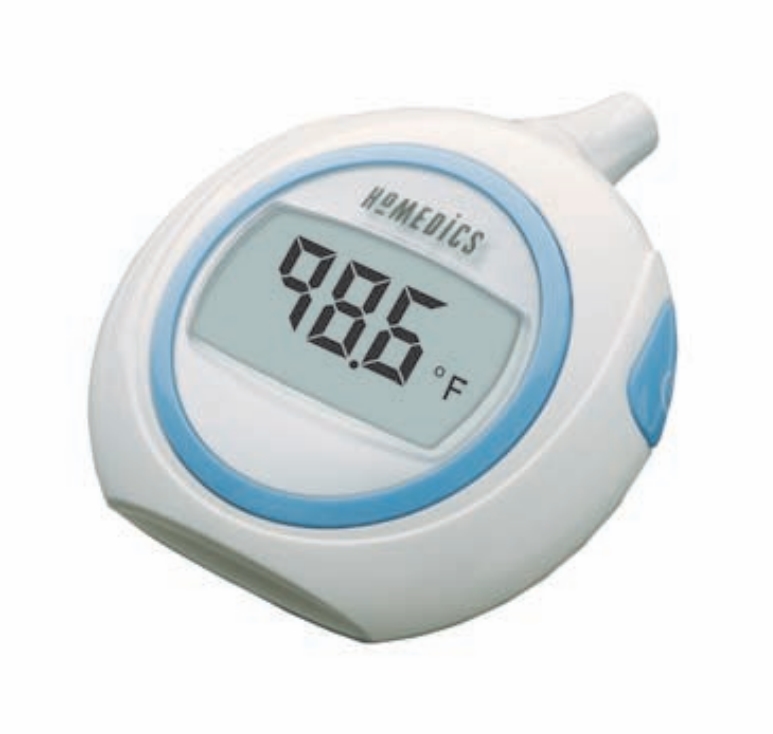One-Second Ear Thermometer
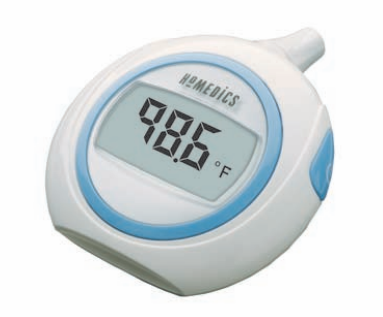
IMPORTANT PRODUCT NOTICES AND SAFETY INSTRUCTIONS
When using your ear thermometer, basic precautions should always be followed. Please read and follow all instructions and warnings before using this product. Save these instructions for future reference.
Please note that this product is intended for household use only and should not serve as a substitute for the advice of a physician or medical professional. Do not use this device for diagnosis or treatment of any health problem or disease. Measurement results are for reference only. Contact your physician if you have or suspect any medical problem.
This ear thermometer is designed for taking temperatures from the ear canal only. Do not use it to take rectal, oral or axillary temperatures. This device is designed for use in human ears only
- Use ear thermometer only for its intended use.
- This ear thermometer should only be used under the supervision of an adult.
- Prolonged high fever requires medical attention – especially for young children.
- Stand or sit still while taking a temperature.
- Thermometer should be used in a dry ear canal.
- Gentle force should be used when inserting the probe into the ear. Excessive force may injure the ear canal or eardrum.
- Do not expose the monitor to extreme temperature, very high humidity, or direct sunlight.
- Handle product with care and avoid dropping.
- Do not immerse the unit in water or other liquids.
- Do not disassemble or attempt to repair the unit.
- When not in use, keep thermometer in its storage case and out of the reach of children.
- Never attempt to insert any object into the probe tip.
- Please observe the following regarding batteries:
- Battery liquid can be harmful to the ear thermometer if leakage occurs. When the ear thermometer will not be used for an extended period of time (three months or more), batteries should be removed.
- A worn battery should be replaced immediately with a new one.
- Observe caution when inserting battery to avoid insertion with polarities in wrong direction.
Additional product notices and safety instructions are found in the following sections of this manual:
- Important notes regarding temperature measurement (pg. 13)
- Special situations in which the ear thermometer should not be used (pg. 15)
- Care, maintenance, and cleaning (pg. 15)
One-Second Ear Thermometer
How does this product work?
This ear thermometer is a delicate and high-tech electronic device designed to measure body temperature. This unit provides accurate and reliable temperature readings by detecting infrared heat from the eardrum and surrounding tissue.
The thermometer takes 512 scans of the eardrum and surrounding tissue in just one second and displays the calculated temperature. The temperature displayed represents the measured ear canal temperature converted to the more familiar oral equivalent. This is performed using a mathematical adjustment of the ear canal temperature. Note that this reading will not necessarily be the same as a temperature measured orally at the same time.
When consulting a physician, it is important to communicate that the temperature reading was taken in the ear and converted to an oral equivalent.
What is normal body temperature? What is a fever?
Normal body temperature is a range that varies from person to person, by age, and throughout the day.
The average normal body temperature is 98.6˚F (37˚C). Fever is defined as a body temperature elevated over an individual’s normal body temperature.
It is important to determine each person’s normal body temperature in order to properly assess whether or not a fever is actually present. This range can easily be determined by tracking temperatures on a consistent basis, using the same ear and measuring at the same time each day.
This ear thermometer converts the ear temperature to an oral equivalent and meets industry standards regarding temperature accuracy. For temperatures between 96.8˚F – 102.2˚F (36.0˚C – 39.0˚C), it is accurate to +/- 0.4°F (+/- 0.2°C). See “Product Specifications” (p.17) for more information.
What is the Fever Alarm?
The Fever Alarm is a unique feature that will alert the user anytime a temperature reading is 100°F (37.8˚C) or greater with a visual notice on the display (a frowning face) and a triple beep audio alert (visual alert only in memory mode). For readings at or above this temperature it is LIKELY that a fever is present.
Note: A temperature reading below 100°F (37.8˚C) does not mean that a fever is not present. Likewise, a temperature greater than or equal to 100°F (37.8˚C) does not guarantee the presence of a fever.
Each individual’s physiology is different and you should monitor your own body temperature to determine your “normal” temperature range in order to determine when a fever is present. Classification of a temperature as a fever also varies by age.
This product is not intended as a substitute for consultation with a physician. Contact your physician if you feel an illness is present with or without a fever.
A physician should be consulted if any of the following conditions are present: Vomiting, diarrhea, changes in breathing, activity, or appetite, irritability, lethargy, or unusual sleepiness.
DEVICE DESCRIPTION
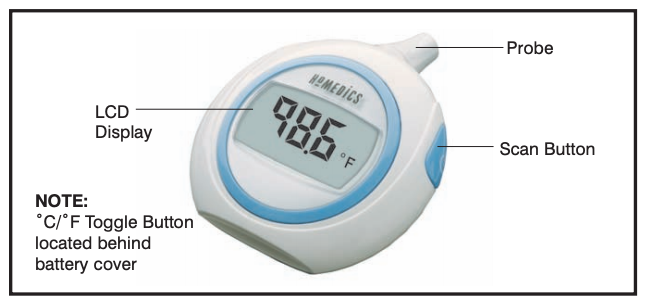
DESCRIPTION OF DISPLAY SYMBOLS
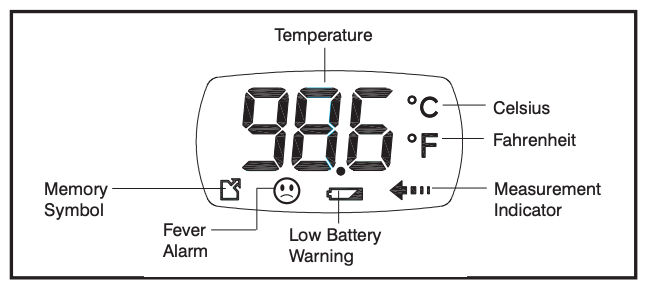
INSERTING AND REPLACING BATTERIES
1. Remove the battery cover as shown in Figure 1.
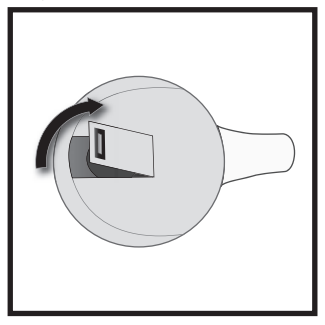
2. Carefully remove the battery by pressing down on the metal clip holding the battery in place. Do not use metal tweezers or a screwdriver to remove the battery.
3. Insert one CR-2032 (3.0 V dc) battery with the plus symbol (+) up as shown in Figure 2.
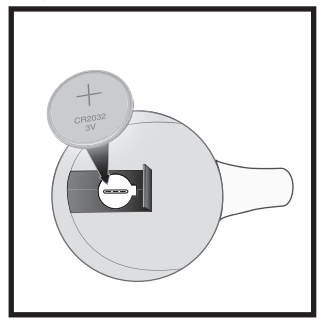
4. Replace the battery cover.
Note that the thermometer will display a default temperature of 00.0˚F/00.0˚C after battery power is restored and until a measurement is taken.
When the low battery symbol appears on the display (Figure 3), the battery should be replaced. When the low battery symbol appears with the “Lo” symbol, the battery must be replaced in order for the ear thermometer to function.
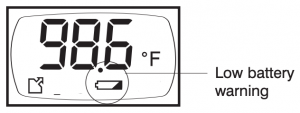
NOTE: Do not discard used lithium batteries in trash. Please turn in at an official collection point. If the monitor will not be used for an extended period of time (three months or more), please remove battery.
CHANGING TEMPERATURE SCALE BETWEEN CELSIUS AND FAHRENHEIT
To switch between Celsius and Fahrenheit readings, simply press and release the “°F/°C” button located behind the battery compartment cover while the unit is on by using a small flat instrument. Once the desired scale is selected, press the “Scan” button to take a new reading or allow the unit to turn off automatically and then turn it back on to view the converted temperature stored in memory.
MEMORY RECALL
This thermometer will automatically store the last temperature measurement in memory. The most recent reading will automatically display when the unit is turned on. Each new temperature reading will replace the temperature stored in the memory.
When viewing a memory reading, the symbol below will appear in the bottom left corner of the display.

HOW TO TAKE A TEMPERATURE READING
1. Always make sure that the waterproof probe has been cleaned with a cotton swab moistened with alcohol since its previous usage.
2. Press and release the “SCAN” button on the side of the device. All display symbols will appear for approximately one second (Figure 1).
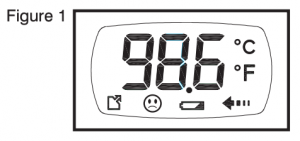
3. When the ear thermometer is ready, the display will next show the results from the last reading. The unit is ready for measurement at this point (Figure 2).
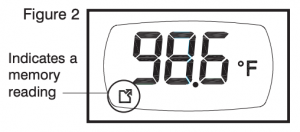
4. Press and release the “SCAN” button again with the ear thermometer outside of the ear. An arrow symbol will appear on the display (Figure 3).
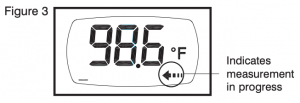
5. Insert the probe tip of the ear thermometer into the ear canal within two seconds (Figure 4). It is important that the probe tip be well positioned within the ear canal. Measurement time for the actual reading is approximately one second.
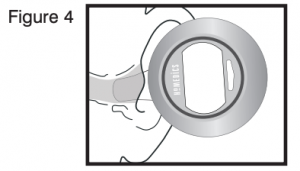
6. A beep sound will indicate the end of the measurement. Results of the temperature measurement will be displayed (Figure 5).
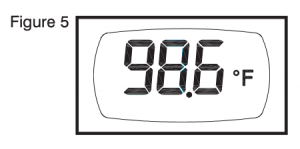
If a temperature reading is greater than or equal to 100˚F (37.8°C), the fever alarm will display a frowning face and will beep three times to alert the user that it is likely that a fever is present (Figure 6). THIS DOES NOT MEAN THAT A FEVER IS NOT PRESENT AT A LOWER TEMPERATURE. For more information on the Fever Alarm feature, please refer to the “What is the Fever Alarm?” section of this manual (page 5).
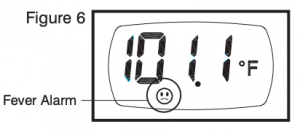
The temperature range of this ear thermometer is 93.2° F (34.0° C)–109° F (43.0° C). If a measurement is below this range, the unit will display “Lo” (Figure 7). If above this range, the unit will display “Hi” (Figure 8).

The unit will display “Err” if the operating temperature is not within the permissible range for measurement (see details in technical section of this manual) (Figure 9).
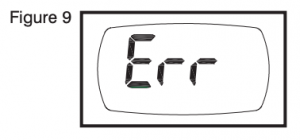
7. The unit will automatically turn off after 30 seconds of non-use.
IMPORTANT NOTES REGARDING TEMPERATURE MEASUREMENT
- The measurement results that users receive are for reference only. If users have any health concerns, please consult a physician.
- It is not necessary to perform an “ear tug” or pull on the ear before taking a temperature measurement.
- For additional measurements, users should wait at least 5 seconds between readings to ensure accuracy.
- Use the ear thermometer at room temperature, as extremes in environmental temperature can impact accuracy. Unit should be stored at room temperature. Before use, the unit must be at room temperature for at least 30 minutes.
- Clean the waterproof probe with a cotton swab moistened with alcohol between readings. Always keep rubbing alcohol/cleaners away from children.
- It is recommended that you take multiple readings (three or more) in the same ear and use the highest reading in the following special circumstances:
- When taking the temperature of an infant younger than three months.
- When taking the temperature of children under the age of three who have special conditions, such as compromised immune systems, and for whom the absence or presence of a fever is critical.
- When you are first learning how to use this ear thermometer and until you are obtaining consistent readings. Note: Slight temperature variations may be observed (+/- 0.3 – 0.5°F or +/- 0.2 – 0.3°C) in consecutive measurements. This is common to all types of thermometers.
- Always take the temperature in the same ear, as readings may differ from one ear to another.
- The ear must be free from excessive earwax buildup or other obstructions in order to take an accurate reading. Note that you should never attempt to clean inside ears, however, as this may result in damage to the eardrum or surrounding tissues. Remove only excess earwax that can be reached with a washcloth. Consult a physician if you suspect excess earwax is present within the ear.
- Ear temperatures may be influenced by external factors, including:
- An ear that has been rested upon or covered
- General exposure to extreme hot or cold temperatures
- Recent bathing or swimming
- Use of hearing aids or ear plugs
- It is recommended that measurement occur at least 20 minutes after these circumstances are no longer present.
- This ear thermometer is for use in human ears only. Do not use for oral, rectal, or axillary temperature measurement.
SPECIAL SITUATIONS IN WHICH THE EAR THERMOMETER SHOULD NOT BE USED
- Pain of any kind is noted during use.
- Blood or drainage is present in the external ear canal.
- Deformities of the ear canal or face exist that prohibit the thermometer from being properly inserted into the ear canal.
- Ear medication or ear drops have been placed in the ear canal.
- Ear infection of any kind is present.
- Individual has been bathing or swimming, as this may lead to injury of ear tissue, as well as inaccurate readings.
CARE, MAINTENANCE & CLEANING
- Clean the unit carefully with a soft, dry cloth. Do not use any gas, strong detergent, or solvents to clean the device.
- Clean the waterproof probe with a cotton swab moistened with alcohol.
- Never attempt to insert any object into the probe tip.
- Do not immerse the unit in water as this will result in damage to the unit. Waterproof portion of unit is limited to probe tip.
- Do not subject the ear thermometer to extreme temperatures, humidity, moisture, and direct sunlight.
- Do not disassemble the ear thermometer. If in need of repair, refer to the warranty section of this manual.
- Do not subject the ear thermometer to extreme shocks (do not drop on floor).
- When not in use, keep thermometer in its storage case and out of the reach of children.
- The thermometer is initially calibrated at the time of manufacture. If this thermometer is used according to the use instructions, periodic readjustment is not required. If at any time you question the accuracy of temperature measurements, please contact HoMedics Consumer Relations at 1-800-466-3342.
TROUBLESHOOTING/ERROR CODES
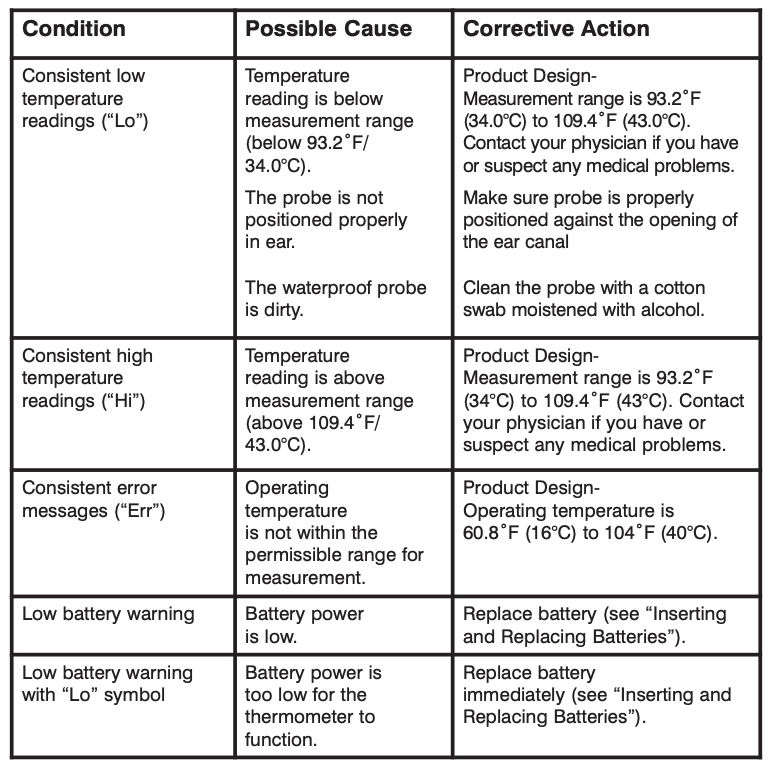
PRODUCT SPECIFICATIONS

NOTE: These specifications are subject to change without notice. This ear thermometer meets requirements established in ASTM Standard E1965-98.
Homedics One-Second Ear Thermometer Manual TE-100 – Homedics One-Second Ear Thermometer Manual TE-100 –
[xyz-ips snippet=”download-snippet”]

